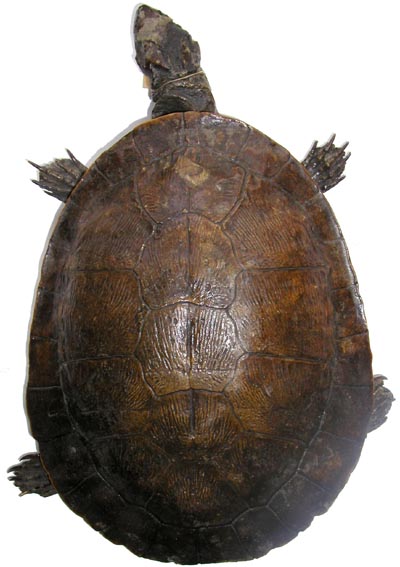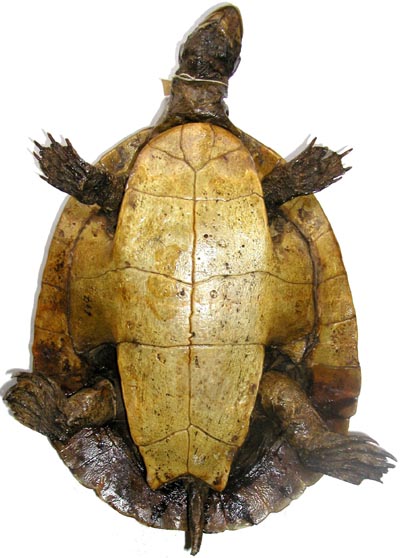Macquarie Turtle -- Emydura macquarii macquarii
by Jan Matiaska
[1]

Introduction
The Murray River Turtle was the first short necked Australasian
chelid to be described. Emydura macquarii macquarii is a nominate
race of the species that also includes other three subspecies:
E. macquarii krefftti, E. macquarii emmotti and E.
macquarii nigra. There is a number of other invalid subspecies that
have been described and later synonymised. This can be accounted to the
species' great morphological variation.
Right photograph [1]: Holotype E. m. macquarii (M. N. H. P. 9409
from Australia) - dorsal view
History and original description
The holotype (M. N. H. P. 9409 from Australia) specimen was collected by René-Primevere Lesson (1794-1849) and Prosper Garnot (1794-1838) in 1824. The type locality is the Upper Macquarie River, in the vicinity of Bathurst [NSW] (Cann, 1998). It was first described by Jean Léopold Chrétien Nicolas Frédéric Dagobert alias Georges, Baron Cuvier (1769-1832) who named the species Em(ys) macquarii. The first valid description was written by John Edward Gray in 1830 and was published in 1831.
Gray's description (1831a):
Macquary's Chelys. Ch. (Hydraspis)
Macquarii. Emys Macquarii. Cuv. R. A. [R.A. means Le Regne Animal]
Shell oval, depressed, contracted in front, behind subdentate, dark olive; shields rugulose; dorsal link sunk; nuchal plate narrow. New Holland.
Gray's (1831b) description is a bit longer, and included measurements:
3. Hydraspis Macquarii, (New Holland Hydraspis.) Testa ovata depressa antice contracta postice expansa dentata olivaceo-fusca, linea dorsali impressa, scutellis rugulosis, nuchali angusto, sterno lutescente. Emys Macquarii, Cuv. MSS. R. A. ii. 11 note. (v. t. Mus. Par.)
Habit. In Novâ Hollandiâ, Macquarrie River.
The hinder marginal plates are nicked in the middle of their edge. Length 11, breadth 8 inches.
Bottom photo [2]: Holotype E. m. macquarii (M. N. H. P. 9409 from
Australia) - ventral view
 For detailed history of the species see my article The
history of the Murray River Turtle - Emydura macquarii macquarii
(Testudines:Chelidae)
For detailed history of the species see my article The
history of the Murray River Turtle - Emydura macquarii macquarii
(Testudines:Chelidae)
Etymology
The generic name Emydura was derived from the
Greek emys (freshwater turtle) and the Greek oura (tail),
Latinized to ura. Its grammatical gender is feminine. The specific
epithet of the species refers to the turtle's type location: the Macquarie
River (Bour, 2005, pers. comm.).
The species common names are Murray River Turtle, Murray River Tortoise, Macquarie Turtle, Murray Short Neck Turtle, etc.
Morphology
The carapace is oval and evenly arched. Its colour ranges from dark brown to light brown. Marginals 4 to 8 turn up in mature specimens (Cann, 1998). Carapace flaring occurs, especially in adult males. The carapace length of females and males can reach up to 340 mm and 300 mm respectively (Cann, 1998). The weight of an adult female can reach 4 kg (Chessman, 1978). The cervical scute is present. Both the vertebral and coastal scutes may apprear to have a wrinkled pattern, but not always.
The plastron is oval, tapered towards the rear lobe and its colour is yellow to bony white. The bridges and ventral parts of marginals are of the same colour. The plastral scutes can be transparent enough to reveal the plastral bone seams which look like light lines.
The head is relatively small compared to the rest of the body. It has two yellow or cream or white bands. One of them is running from the angle of the mouth along the neck. The other one is under the jaw forming a "V" shape (Cann, 1998). The iris of the eye is yellow while the pupil is black. The neck is covered with tubercles and there are two barbells on the chin.
Dorsal skin parts are grey and ventral parts are light grey with bits of bony white or yellow here and there.
